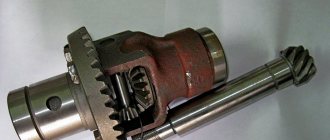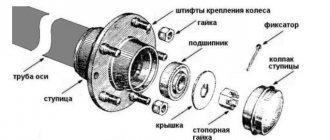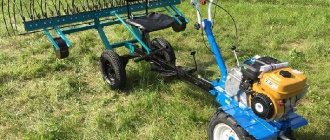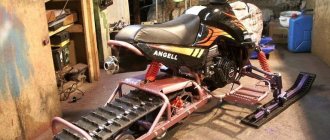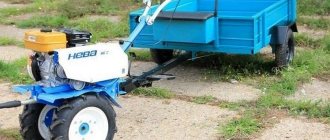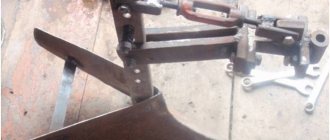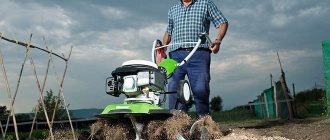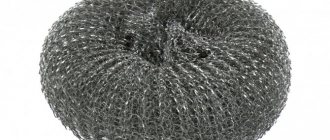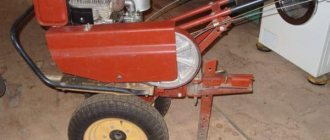The differential for a walk-behind tractor is a mechanism included in the design of the vehicle. It is an integral element of the power drive, equipped with several wheels on one axis. Drawings of homemade differentials have become widespread on specialized websites.
The main purpose of the differential device involves distributing power between the wheels of the unit. Making a differential is not difficult. Its presence in the structure is necessary for the device to pass through all turns normally.
Since the wheel that passes along the outer arc of the turning path must simultaneously travel a longer distance than the one that follows the first one within the inner arc, its rotation must occur faster, otherwise slipping of the mechanism can be observed. The absence of a differential on the axle causes its movement to be straightened, the effect of which increases with increasing distance between the wheels of the unit.
Options for power distribution mechanisms
Structurally, the simplest way to solve the problem arising from the rigid connection of the wheels is to use overrunning clutches, which allow the wheel to rotate faster than the axle driving it.
Overrunning clutches
This mechanism is well known in all its variations: both with a ratcheting mechanism (bicycle wheel hub) and with wedging rollers (electric starter bendix).
Overrunning clutches are also used in the power drive of a number of cars with plug-in axles. However, this solution has a characteristic feature: when cornering, the overrunning clutch is disconnected on the wheel running along the outer radius, as it tends to rotate faster than the drive shaft.
To make it easier to enter a turn, on the contrary, most of the torque should be transmitted to it.
This problem is solved in the classic gear differential , which distributes power in inverse proportion to the rotational resistance of the wheels.
But it is also noticeably more difficult to produce, and also requires forced full or partial blocking on off-road conditions, since otherwise it redistributes all the power to the slipping wheel.
Types of mechanisms
There are several types of distribution mechanisms used in various models of walk-behind tractors. They differ significantly in their performance characteristics and have their own advantages and disadvantages. Most often, the unit can be equipped with the following components:
- rigid drive, which provides for uniform distribution of power across a pair of wheels, which is most often used on two-axle modifications;
- overrunning clutch, characterized by a simple design, capable of increasing the torque of 1 drive wheel through more active rotation of the axle;
- classic gear-type differential, which allows you to distribute the load between the axles when turning in inverse proportion.
The last variety, which seems to be the most effective, deserves special explanation. A walk-behind tractor with a differential lock is capable of increasing torque on one side when turning and significantly reducing it on the other, which allows you to successfully complete the maneuver.
Be sure to read: Do-it-yourself tuning of MTZ 80 with a small cabin
Need for differential
Many works performed with a walk-behind tractor (for example, cultivation) require its linear movement . In this case, a rigid drive on both wheels works great, significantly reducing the cost and simplifying the walk-behind tractor.
If frequent sharp turns are necessary, a walk-behind tractor of this type will require significant physical effort - one of the wheels will be braked by lugs, and the walk-behind tractor will have to tilt, hanging the outer wheel in the air.
This is especially difficult if the walk-behind tractor has a wide track and is quite heavy.
How to make a homemade differential for a walk-behind tractor with your own hands - drawings
How to make a differential for a walk-behind tractor with your own hands? As a rule, the operation of a walk-behind tractor does not require long-term rotation of the wheel relative to the drive axis.
Due to this, often called “semi-differential” schemes are common, which provide the ability to freely rotate the wheel relative to the axis at a certain angle.
For more information about the “semi-differential”, watch the video:
The simplest mechanism in this case looks like a bushing with a transverse slot attached to the axis of the walk-behind tractor. A short axle is inserted inside this bushing, secured from falling out by a bolt wrapped into its body through a slot, and the wheel is attached directly to the axle.
In this case, when the walk-behind tractor moves, the drive axle rotates the bushing freely until the rear edge of the slot rests against the bolt, and then transmits torque to the axle through it.
Soil cultivation is one of the main agrotechnical activities, which is a mandatory part of the annual soil cultivation regime. By clicking on the link, you will get acquainted with the convenient and practical Loplosh cultivator.
A snowmobile allows you to quickly and comfortably move through the snow from one point to another, while also carrying a passenger or some kind of cargo. Here is the lineup and prices of 2016 Yamaha snowmobiles.
The quality of the grown products, its productivity, and, ultimately, the return on financial and physical investments depend on the timely and high-quality use of special means when growing crops. Here you will learn how to make a sprayer with your own hands.
During a turn, the wheel, trying to overtake the drive, moves the bolt forward along the slot, breaking the transmission of torque, and the angle of easy rotation of the walk-behind tractor depends on the length of the slot.
Such extension cords are extremely simple and can be made by unskilled machine operators, and therefore are cheap and widespread. They are usually made with several additional holes, allowing you to vary the track width of the walk-behind tractor and rigidly connect the wheel to the drive axle if necessary.
Drawings of these homemade differentials are widely distributed on the Internet.
The disadvantage of the described design is the relatively small possible angle of free rotation of the wheel (no more than 240 degrees), since the transverse groove greatly reduces the overall strength of the mechanism, and high internal friction, especially when dirt inevitably gets inside the bushing.
Most often, extension cords with free movement are used on light walk-behind tractors, like the Niva.
The differential for walk-behind tractors Salyut and the like Texas, Foreman, Viking, Forza, Sadko, Don, Huter, Profi, which have a relatively large mass, has a slightly more complex design, but also a larger free play angle - within 330 degrees.
DIY constructive mechanism
To personally make a homemade differential for a mechanism such as a walk-behind tractor, you should pay special attention to the work. In this case, it is necessary to consider in detail the entire algorithm of actions for the manufacture of such parts:
- First of all, it is necessary to take into account the design features of the equipment used (special equipment).
- It is also important to choose the optimal installation option that suits the design features of the technical device.
- You need to download and print a diagram with exact dimensions or make it yourself.
- Next, all the elements for the manufacture of such a mechanism are selected separately (hubs, for walk-behind tractors, gears, camshaft and other components).
- Next, you also need to choose the option of manufacturing such a device as a differential for special equipment.
- Study in detail all the materials regarding how such a mechanism is performed in practice with your own hands.
- After studying the theory and preparing the necessary components, you also need to select the tools.
- During the assembly process, it is also recommended to use the appropriate video instructions that are available on the Internet.
- All prepared elements must first be adjusted to a single size that is used on the walk-behind tractor.
- Subsequently, according to the instructions, all structural components are assembled together.
- At the end, the part is checked for functionality, and only after that it is installed on the axle of special equipment.
This design should be made strictly according to the instructions.
When manufacturing such a mechanism, it is necessary to ensure that the free movement of this part does not exceed 240 degrees. During manufacturing, it is necessary to adjust the parts in such a way that free movement is ensured, which will not be obstructed by anything.
Important! When manufacturing this equipment, it is necessary to take into account the fact that the differential is subject to a heavy load from the power plant, which is why the part must be checked accordingly so that it can withstand the transmitted loads during subsequent operation.
If you make a differential for a walk-behind tractor yourself, you must strictly observe all dimensions and also avoid gaps, otherwise this type of equipment will not last long. When creating a design, it is also important to use only high-quality materials that were used to create factory components.
Additionally, it should be noted that there is no need to purchase all the parts for the device, since spare parts previously installed on the walk-behind tractor can be used for this element. In other words, you can remove the working mechanism from a technical device for cultivation, and then modernize it so that it meets all the requirements of the owner of the special equipment.
General Tips
Let's start with the simplest option in the form of an axle extension with a transverse groove . It will be quite reliable even if made from affordable mild steel.
Axle extension
It is better to use a bolt connecting the components of the extension with an internal hexagon head and mill a groove with a width equal to its outer diameter.
In this case, firstly, there are no protruding parts capable of wrapping grass around itself, and secondly, a bolt tightened all the way will not become loose over time.
The gap between the bushing and the extension axle cannot be made too small , since if corrosion occurs they will become acidic to each other. It is highly advisable to place a grease fitting on the bushing for in-place lubrication of the structure.
The more complex rotary hub design can also be made from mild steel as it is easily welded.
Finishing of the bearing holes in the hub must be done after the flange and rotation angle limiter are welded due to the inevitable warping of the part during welding.
Making a differential for a walk-behind tractor yourself cannot be called a technically difficult task, and this is proven both by the experience of many owners of garden equipment and by the fact that common offers in online stores copy originally handicraft designs.
The invested labor costs will quickly pay off by facilitating the operation of the walk-behind tractor.
Making a hub - step-by-step algorithm
As in the case of a differential, to manufacture a hub for a walk-behind tractor, you will need to prepare drawings. A detailed diagram will make it possible to complete the work faster and avoid common mistakes.
The correct sequence of actions when making a hub is as follows:
- First you need to grind the workpiece. To do this, any metal part is taken and processed on a lathe;
- A fairly popular option is to make a flange and then weld it to a metal pipe or rod. When processing a part, you should be extremely careful and observe the dimensions indicated in the selected drawings;
- It should be remembered that during operation the hub will be subject to constant loads, which is why it is better to choose a reliable material for making it yourself - for example, hardened steel.
After manufacturing the hub, it can be installed on the walk-behind tractor and tested in operation.
You should not place high loads on the part immediately after installing it on the unit - otherwise it may become deformed. It is best to walk with the walk-behind tractor several times on a flat surface in the yard, turning the car around several times. After this, the hub will finally fall into place, and the unit with it can be used for work in the garden. A self-made differential or hub can be successfully used to equip Neva brand walk-behind tractors. The design of the units of this brand allows you to easily install the part, and, if necessary, remove it easily and quickly.
Differential for a walk-behind tractor - how it works and what it’s capable of
Diary entry created by user CaimanTeh, 02/26/15 .353,
Recently, a video of the Caiman Vario walk-behind tractor with a snow thrower attachment was posted on YouTube. During the story about the features of winter use of the walk-behind tractor, “additional differentials” installed on the wheels were mentioned.
To demonstrate the differentials, Denis turned the walk-behind tractor back and forth. The demonstration was short, but this option interested the participants in the Pubert & Caiman Motor Tillers
In the topic, it seemed like they quickly figured out what these additional differentials were for a walk-behind tractor, but since the question arose, I decided to make a short photo report. After filming, the demonstration walk-behind tractor with a differential was full of gasoline and oil, so it was taken to the service room. It's cramped there, there's a lot of other equipment around, so we couldn't spin it. All I got from Caiman Vario was a photograph.
Differential for Caiman Vario walk-behind tractor
So, here are these differentials, or rather semi-differentials installed together with standard rubber wheels of size 4.00-8. (The set of two semi-differentials is called “Differentials with extensions for the VARIO/Q Junuor/Q Max walk-behind tractor” and has code R0101.)
How it's done
The design of such differentials for walk-behind tractors (and walk-behind cultivators, by the way) is extremely simple:
- the wheel hub is not secured to the axle
- there are protrusions on the axle and hub (indicated by green arrows) that prevent the wheel from turning a full turn
How it works
During normal movement of the walk-behind tractor, the protrusion on the axle rests against the protrusion on the hub and transmits rotation to the wheel. In this case, both wheels will rotate simultaneously.
But if you push the walk-behind tractor forward, the differential hubs will work as overrunning clutches, and the protrusions on the wheels will “run away” from the protrusions on the axle. They won’t be able to run far - having made almost a full turn, the protrusion on the hub will touch the protrusion on the axle, but this will be enough to complete the maneuver.
After completing the turn, the walk-behind tractor with the differential will be able to move only at the expense of one wheel until the protrusion on the axle of the second wheel “catch up” with the protrusion on the hub. It is also possible to slip one wheel until the “unlocked” one comes into working condition.
Why do we need differentials for a walk-behind tractor?
To put it simply, the walk-behind tractor needs differentials to turn at the end of the furrow. This is how the same Caiman Vario turns around on lugs and without differentials.
To turn the walk-behind tractor and return to the cultivated area, the lugs have to be dragged along the ground. And here it all depends on the weight of the walk-behind tractor (or cultivator) and the strength of the operator.
At the end there will be a video showing how much differentials make this task easier.
Differentials on the Pubert Quatro Junior walk-behind tractor
Above was a picture with a differential hub different from that installed on the Caiman Vario - in the showroom there was another walk-behind tractor with a similar design of differentials.
Differentials on the Pubert Quatro Junior walk-behind tractor
Unlike previous domestic differentials suitable for several models, these are part of the native French “Plowing Kit” (code 8000010205) for the Quatro Junior and QJ V2 models (Caiman, Pubert and MasterYard, including models with a diesel engine) which includes includes:
- differentials
- wheels 5.00-10
- weights
- reversible plow
Quatro Junior with this kit has a wide track and weighs over 100 kg. In order to turn it around with its wheels locked, you need to be either very strong or very stubborn. In any case, such a turn at the end of each furrow will take a lot of time and effort in total.
Differentials, unlockers, overrunning clutches, etc.
Yeees! But without diffs I drove five times or more. I can’t say for sure, I don’t have a speedometer
Well, any diff is connected to the wheels or gearbox using holes and bolts. I think they won't break much less.
And another minus is the large camber of the wheels due to additional play in the diff itself. This of course does not apply to serious diffs.
I am more tormented by the question: How does the gearbox feel better, with or without a diff?
ZeVic wrote: I am more tormented by the question: How does the gearbox feel better, with or without a diff?
If the design of the differential causes dynamic shocks on the output shaft of the gearbox, then I think it will be easier for the gearbox without a differential.
Yes. But on the other hand, there are the typical twisting moments on the output axis of the gearbox when turning.
Once upon a time, your sales consultant at Budyonny did not recommend differentials for Salut. He said that this is an additional load on the gearbox. He referred to specialists from the factory.
ZeVic wrote: Yes. But on the other hand, there are the typical twisting moments on the output axis of the gearbox when turning.
Example (probably not a good one?)
Try pushing a nail into a board with a hammer without swinging it.
(Static load) And by swinging a hammer, a craftsman will drive a nail into the board with one blow. (Dynamic load uses inertial forces)
After all, probably something similar can occur in the axle assembly of a motorcycle if you use the described differential principle.
ZeVic wrote: Once upon a time, your sales consultant at Budyonny did not recommend differentials for Salute. He said that this is an additional load on the gearbox. He referred to specialists from the factory.
Some kind of nonsense. Think for yourself, if you use a real one, it can only have a beneficial effect on the life of the gearbox!
UV wrote: Some kind of nonsense. Think for yourself, if you use a real one, it can only have a beneficial effect on the life of the gearbox!
Actually, I thought so too. They probably meant an increase in the load on the gearbox simply by lengthening the differential shaft.
UV wrote: How does the pseudo-dif behave and help when turning? In theory, dynamic shocks should occur in the node, how strong are they?
Drives excellently when cornering. There are impacts, but not significant. Worked on plowing, total weight with additional load MB
kg 230 there were no problems. Without additional loading the blows are stronger. I don’t use it as a transporter yet.
ZeVic wrote: But on the other hand, there are non-Detish twisting moments on the output axis of the gearbox when turning
Try to turn a 230 kg MB with a GZ without a differential - it’s the same as lifting a horse and turning it around.
ZeVic wrote: He said that this is an additional load on the gearbox.
I agree, but during a turn. The load will be on one axle, so in other switchable locking schemes the same canoe, but factories do it. Actually, this is a simple way of unlocking and I’m already used to it, the main thing is that it helps with the work, and whatever inconveniences arise, you get used to it. I don’t like racing. And the belt clutch softens the impact on the engine - it doesn’t feel it, judging by the sound of the engine. Cheap and cheerful. It’s not possible to find something suitable here, except for UAZ locks, but at a price of 5 thousand, and you need two of them - the total cost is half a MB and why the hell do you need it. Go for it. Good luck.
These are the kind of axle unlockers with steel balls that the Japanese made in Honda walk-behind tractors already in the 1970s.
And they are trying to make an unlockable axis based on balls in Russia, but at the present time. » >
And an unlock option with a plug
Alvis wrote: A weak point in the unlockers was revealed: at the end of the autumn work, the clutch fingers were twisted and torn off. This unit will need to be strengthened.
I remade the clutch fingers to be more durable and the surface of the fingers was charred, that is, metal sementation was carried out
Thanks to 52dim, thanks to him I bought this device on Zubrik
Express your pros and cons.
Agrowest wrote: I bought this device on Zubrik. Express your pros and cons.
If this "finger"
made of St3 steel and dimensions about 10x10, then it can be rolled up.
Alvis wrote: then he can fold it.
How to make a differential for a walk-behind tractor with your own hands
Motorized cultivators have recently been in great demand among agricultural workers. As for the differential for a walk-behind tractor, it is an integral part of the design of the vehicle’s power drive. This is an element with several wheels that are located on the same axis. Despite the fact that initially this part may seem quite complicated, it is not only easy to repair, but you can make a differential for a walk-behind tractor with your own hands. There are many diagrams and drawings that are successfully used by both specialists and beginners in this matter.
Why does a walk-behind tractor need this element?
The walk-behind tractor wheel, which follows an outer arc when turning, must travel a longer distance. And here the need arises for a differential or other mechanism for distributing power, which will avoid slipping. If the wheel device does not have this element, this will cause straightening of the movement. Moreover, the greater the distance between the wheels, the more difficult it will be to turn.
The main part of the work that is carried out on the ground, for example, cultivation or fertilization, is carried out in a straight line. But this does not mean that the device will never turn. Of course, the standard version of a walk-behind tractor with a rigid 2-wheel drive makes it quite convenient to use in most agricultural work. But if frequent turns are necessary, the problem with slippage and control will have to be additionally solved. If special mechanisms are not used, the vehicle will be braked by lugs. Such work will be difficult even for a person with great physical strength.
Most often, experts choose to use overrunning clutches as a solution to this issue.
These are simple and universal installations that allow you to correctly distribute the load between the wheels if you need to turn the walk-behind tractor. The versatility of this method lies in the fact that overrunning clutches can be used not only on a rigid axle, but also on a connected one. In this case, when turning, the wheel will tend to rotate faster than the front shaft. This makes it possible to conveniently operate the machine and work even in small areas, as the device becomes more maneuverable.
Purpose of this element
Before you familiarize yourself in detail with the varieties, manufacturing options and mounting method, you need to consider why a differential is installed on a walk-behind tractor, namely:
- The main function of this device is to distribute power between the wheels of special equipment.
- At the moment of rotation of the wheel relative to the axis, this mechanism does not allow the element passing along a smaller radius to slip.
- A load is regularly placed on the differentials, provided that rotation of the wheels is created relative to the axis in a different projection (when cornering).
- The device allows you to process a relatively large mass (the load that appears when the direction of the axis changes).
In other words, if special equipment or other vehicles are not equipped with these mechanisms, then when turning, a significantly greater load will be placed on one side, which will entail a gradual failure of the entire suspension.
Important! Due to their fairly simple design, differentials for a walk-behind tractor can be made independently, but here it is first necessary to create an appropriate diagram of this element.
In this video you will learn how to make a differential for a walk-behind tractor: It is recommended to assemble and install a device such as a differential for a walk-behind tractor, provided that you have the appropriate education and experience. If you lack skills in this matter, then you can always contact our company, where qualified employees will be ready to undertake the manufacture and installation of the device on special equipment. All work is done quickly, reliably and efficiently. At the same time, we charge a modest fee for our services.
Simple design for a walk-behind tractor
Many farmers, when using conventional equipment, often think about how to make a differential for a walk-behind tractor with their own hands. A similar idea may come to a repairman if an old element breaks down. There are no particular difficulties in making a differential for a walk-behind tractor with your own hands. But first, you should stock up on a suitable diagram or prepare drawings.
Those who are thinking about what type of differential to choose for a walk-behind tractor should remember that this type of equipment does not require prolonged rotation of the wheels relative to the axis. That is why you can choose the simplest options.
Often, universal differential systems are used for walk-behind tractors. They allow the wheels to deviate from the axis by a certain degree.
In the simplest version, you need to take a bushing with a transverse slot and insert a short axle into it. The last element must be fixed with a bolt, and only then attached to the wheel structure. This system works quite simply. The drive axle must turn the bushing all the way, that is, until it hits the bolt. It is worth noting that with this element the master can initially set the most suitable wheel rotation angle for him, which also depends on the size of the slot.
The peculiarity of this detail is its maximum simplicity. You don’t have to be an experienced craftsman or mechanic to make such a differential for your walk-behind tractor. You just need to have certain skills in operating a machine. This will be enough to obtain the basic elements needed to make such a differential.
Tips for choosing a hub for a walk-behind tractor
On the open market you can always find a large selection of hubs designed for installation on various models of walk-behind tractors.
In order not to make a mistake when choosing a part, farmers should adhere to a number of certain rules:
- when ordering a hub for a walk-behind tractor, you should indicate the class and model of the agricultural implement;
- in most cases, when selling a walk-behind tractor, one set of hubs is included in its kit. In this case, when using attachments, there is no need to rearrange the hubs. This, in particular, applies to the lugs used on the walk-behind tractor. This feature will save a lot of time when working in the garden;
- If the walk-behind tractor is equipped with pneumatic wheels, then its delivery set will necessarily include hubs.
By adhering to these simple rules, every novice farmer will be able to choose a walk-behind tractor equipped with hubs or choose the right parts, separately from the agricultural machine.
Advantages and disadvantages
The main advantage of this method of solving the problem of turning wheels is the simplicity of the design. In addition, such a differential is universal, as it is suitable for almost all types of walk-behind tractors.
But the semi-differential also has its disadvantages. Here, first of all, you need to note the small angle of rotation that will be available after installing such a structure. This type of mechanism does not allow rotation of more than 240º. Many farmers note that the presence of a transverse groove makes the structure not very strong. If the load is significant, the axle may break. Therefore, those who decide to use their own made differentials for a walk-behind tractor should be prepared for the fact that the structure will periodically have to be repaired and remodeled.
Considering all the pros and cons, we can say that for those who are not too demanding of their walk-behind tractor and lightly load it with straight and rotary work, a semi-differential is perfect. For serious loads, it is worth looking for more durable structures.
